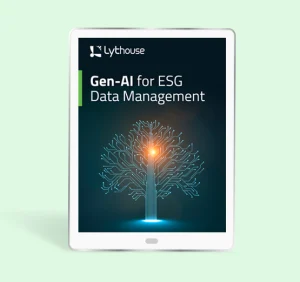In today’s fast-evolving business landscape, integrating Environmental, Social, and Governance (ESG) considerations into risk management is an ethical choice and a strategic necessity. With over 77% of institutional investors stating that ESG factors are central to their investment decisions, it’s clear that the stakes for businesses have never been higher.
Developing a robust ESG Risk Management Framework has become crucial for organizations aiming to mitigate risks, capitalize on opportunities, and build resilience against the backdrop of a rapidly changing world.
What do You Understand by ESG Risk Management?
Before delving into the specifics of an ESG Risk Management Framework, it’s essential to grasp the significance of ESG and risk management as standalone concepts.
ESG encompasses a business’s environmental, social, and governance practices that may significantly impact its performance, reputation, and stakeholders. On the contrary, risk management involves identifying, assessing, and controlling threats to an organization’s capital and earnings. ESG and risk management form a holistic approach that ensures long-term sustainability and success.
Overcoming these challenges is no small feat. It demands sustained commitment, strategic vision, and a willingness to invest in long-term change. However, the rewards of successfully implementing an ESG Risk Management Framework are substantial.
Organizations that navigate these hurdles effectively can enhance their resilience, unlock new opportunities for sustainable growth, and position themselves as leaders in the transition to a more sustainable and equitable global economy.
How Can You Build an ESG Risk Management Framework?
Creating an ESG Risk Management Framework involves several critical steps. Drawing insights from leading experts like Deloitte, EY, and KPMG, we outline a clear path for businesses to follow:
1. Establish Clear ESG Objectives
The first step is to define what your organization aims to achieve with its ESG initiatives. This involves setting clear, measurable goals that align with your business’s overall strategy and values.
2. Conduct a Comprehensive ESG Risk Assessment
Identify your business’s specific ESG risks, considering factors like environmental impact, social responsibility, and governance practices. This process should be thorough, incorporating both internal assessments and stakeholder feedback.
3. Develop a Risk Management Strategy
Once risks are identified, businesses must formulate strategies to mitigate or eliminate these risks. This may involve revising operational processes, adopting new technologies, or changing supplier relationships.
4. Implement ESG Risk Management Processes
Once the strategy is in place, the next step is implementation, which includes integrating ESG considerations into everyday business operations and decision-making processes.
5. Monitor and Report
Proactively monitoring and reporting ESG performance are vital as they help track progress against objectives and communicate efforts and outcomes to stakeholders.
6. Continuous Improvement
The ESG landscape is continually evolving, and so should your ESG Risk Management Framework. Regularly review and update your strategies and processes to adapt to new challenges and opportunities.
What Makes ESG Risk Framework Important for Enterprises? – An Insight
An effective ESG risk framework offers numerous benefits like the following:
- It enhances risk management by providing a comprehensive view of potential ESG risks and their impacts. This proactive approach helps identify and address issues before they escalate, protecting the organization’s reputation and financial performance.
- Moreover, it aligns with the growing expectations of investors, customers, and regulators, who increasingly demand transparency and accountability on ESG matters.
Mitigate ESG Risks Effectively: Get your copy of our Gen-AI e-Book
How Can You Overcome ESG Risk Management Challenges?
Implementing an ESG Risk Management Framework brings a multitude of benefits, from enhanced reputation and investor confidence to improved sustainability and compliance.
However, the path to integrating such a framework is fraught with challenges that require careful navigation. Among these, the need for significant cultural change, the integration of ESG considerations into all levels of decision-making, and the development of new skills and capabilities stand out as primary hurdles.
Let’s delve deeper into each of these challenges:
1. Significant Cultural Change
Adopting an ESG Risk Management Framework necessitates a fundamental shift in organizational culture. This shift involves moving away from short-term profit maximization to prioritizing long-term sustainability and ethical considerations. It requires embedding environmental, social, and governance values into the corporate DNA, which can be a considerable challenge for organizations entrenched in traditional ways of operating.
Achieving this shift often means overcoming resistance to change among employees and leadership, necessitating a top-down commitment from senior management to model and drive the desired cultural transformation.
2. Integration of ESG Considerations into Decision-Making
Another major challenge is ensuring that ESG considerations are woven into the fabric of all decision-making processes. This requires a systemic change in decision-making, necessitating ESG risk assessment incorporation in everyday business operations, from supply chain management to product development.
Organizations must develop mechanisms to quantify and integrate ESG risks and opportunities into their strategic planning, investment decisions, and performance evaluation criteria.
Achieving this level of integration demands robust frameworks and tools that can seamlessly blend ESG factors with traditional financial metrics, which can be daunting for many businesses.
3. Development of New Skills and Capabilities
The effective implementation of an ESG Risk Management Framework also hinges on the organization’s ability to develop new skills and capabilities. As ESG criteria encompass a wide range of issues—from climate change and resource scarcity to social inequality and corporate governance—addressing them requires specialized knowledge and expertise.
Organizations must invest in training and development programs to equip their workforce with the necessary skills to effectively identify, assess, and manage ESG risks. Moreover, they may need to bring in external experts or establish dedicated ESG roles and teams to spearhead these efforts.
Developing these capabilities is crucial for creating the internal infrastructure needed to support a comprehensive ESG strategy.
How can you integrate Climate Risk into ESG Risk Management Frameworks?
In today’s dynamic environmental landscape, managing climate risk within an ESG framework is not just beneficial—it’s essential. By adopting advanced analytical tools and aligning with global standards such as the Task Force on Climate-related Financial Disclosures (TCFD), organizations can enhance their resilience to climate variability, meet investor expectations, and stay compliant with regulatory requirements. This strategic integration not only protects the business but also positions it as a leader in sustainability, driving both stakeholder value and competitive advantage.
How Lythouse Facilitates ESG Risk Management?
Lythouse equips organizations with advanced tools to manage ESG risks effectively. Our Carbon Analyzer ensures precise tracking of carbon emissions, promoting transparency. The Green Supplier Network enhances Scope 3 emissions management and supports supplier collaboration. The Goal Navigator facilitates the setting and achievement of ESG goals, while the ESG Reporting Studio streamlines compliance with global frameworks, ensuring accurate reporting. These integrated solutions help companies improve ESG performance and meet regulatory standards efficiently.
Conclusion
As we navigate the complexities of the 21st century, integrating ESG considerations into risk management is no longer optional but imperative. An ESG Risk Management Framework is a powerful tool that enables businesses to identify, assess, and manage risks effectively, ensuring longevity and relevance in a rapidly changing world.
By adopting such a framework, organizations can safeguard their interests and contribute positively to the global push for sustainability and social responsibility.
Share your thoughts on the importance of ESG in risk management and the challenges and successes you experienced in implementing an ESG Risk Management Framework.
Let us collectively navigate this crucial aspect of modern business strategy and shape a sustainable future for all. Book a demo today!
FAQ’s:
1.What is ESG Risk Management?
ESG Risk Management involves identifying, assessing, and mitigating risks associated with environmental, social, and governance factors that could impact an organization’s performance and reputation.
2. How does climate change affect ESG risk management?
Climate change introduces physical and transitional risks that organizations need to manage. These include increased operational costs due to extreme weather events and regulatory changes aiming for a low-carbon economy.
3. What are the key components of an ESG risk management framework?
Key components include risk assessment procedures, integration of ESG risks into the overall risk management strategy, stakeholder engagement, and continuous monitoring and reporting.
4. Why is ESG risk management important for investors?
ESG risk management is crucial for investors as it helps identify potential risks and opportunities, ensuring that investments are sustainable and align with long-term environmental and social values.
5. How can technology enhance ESG risk management?
Technology can enhance ESG risk management through data analytics tools that provide deeper insights into ESG performance, automate data collection, and improve the accuracy and efficiency of reporting processes.
6. What makes ESG Risk Framework important for Enterprises?
An effective ESG risk framework offers numerous benefits like the following:
It enhances risk management by providing a comprehensive view of potential ESG risks and their impacts. This proactive approach helps identify and address issues before they escalate, protecting the organization’s reputation and financial performance.
Moreover, it aligns with the growing expectations of investors, customers, and regulators, who increasingly demand transparency and accountability on ESG matters.
Recommended Read
- ESG Risk Management: Identifying, Assessing, and Mitigating ESG Risks
- ESG Risk Management: Understanding and Navigating Environmental, Social, and Governance Risks
- ESG Reporting for the Public Sector: How to Demonstrate Your Commitment to Sustainability

Amelia Rose is a leading expert in Environmental, Social, and Governance (ESG) issues. She brings a deep understanding of ESG, sustainability, climate change, sustainable development, and corporate social responsibility to her work. Rose has extensive experience in consulting with businesses and organizations on developing and implementing effective ESG strategies. She is a passionate advocate for a greener future and believes that businesses can be a powerful force for positive change.







